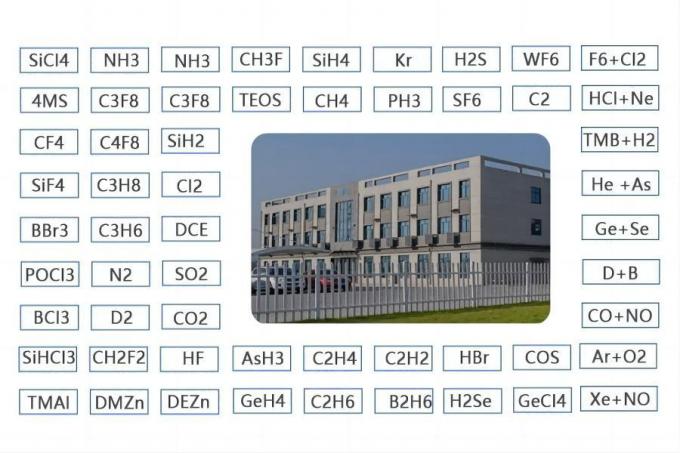


| MOQ: | 1 Piece |
| Price: | US $300/PC |
| Standard Packaging: | Cylinder/Tank |
| Delivery Period: | 15 days |
| Payment Method: | L/C, T/T |
| Supply Capacity: | 3000 Pcs/Month |
Helium gas is a colorless, odorless, and tasteless element that belongs to the noble gas group on the periodic table. It is represented by the chemical symbol He and has an atomic number of 2. Helium is the second lightest and second most abundant element in the universe, after hydrogen.
Key characteristics of helium gas include its low density, low boiling point, and low solubility in water. It is lighter than air and has a tendency to rise, which is why it is commonly used to fill balloons and airships. Due to its low boiling point of -268.93 degrees Celsius (-452 degrees Fahrenheit), helium remains in a gaseous state at normal temperatures and pressures.
Helium is widely used in various industries and applications. One of the primary uses of helium is in cryogenics, where it is utilized to cool superconducting magnets in MRI machines, particle accelerators, and other scientific research equipment. It is also used as a coolant in nuclear reactors and as a heat transfer medium in some high-performance cooling systems.
In addition to its role in cryogenics, helium is utilized in gas chromatography, as a shielding gas in arc welding, and in the production of semiconductors and fiber optics. It is also employed in certain breathing mixtures for deep-sea divers and in high-altitude aviation due to its low density and ability to reduce the risk of decompression sickness.
Helium is a non-renewable resource, and its availability on Earth is limited. It is primarily extracted from natural gas fields, where it is often found in small amounts. Due to its scarcity, there have been concerns about a global helium shortage and efforts to conserve and recycle helium gas.
It's important to note that inhaling helium directly from a pressurized source or from a balloon can be dangerous and potentially life-threatening. Breathing in helium can lead to a lack of oxygen and asphyxiation, as it displaces the air in the lungs. Helium should only be used for appropriate industrial and scientific purposes under controlled conditions.
Basic Info.
| DOT Class | 2.2 | Un Number | 1963 |
| Cylinder Standard | DOT/ISO/GB | Cylinder Pressure | 15MPa/20MPa |
| Valve | Qf-2/Cga580 | Melting Point | -272.2 ºC |
| Appearance | Colorless, Odorless | Boiling Point | -272.2 ºC |
| Density | 0.1786 Kg/M3 | Molecular Weight | 4.0026 |
| Transport Package | 40L, 47L, 50L | Specification | 99.999%, 99.9999% |
| Trademark | CMC | Origin | Suzhou,China |
| HS Code | 28042900 | Production Capacity | 20, 000 Tons/Yea |
![]()
![]()
| Specification | Company Standard |
| He | ≥ 99.999% |
| N2 | ≤ 2.0 ppm |
| O2+AR | ≤ 1.0 ppm |
| H2 | ≤ 1.0 ppm |
| CO | ≤ 0.5 ppm |
| CO2 | ≤ 0.5 ppm |
| Ne | ≤ 1.0 ppm |
| CH4 | ≤ 0.5 ppm |
| Moisture | ≤ 0.5 ppm |




| MOQ: | 1 Piece |
| Price: | US $300/PC |
| Standard Packaging: | Cylinder/Tank |
| Delivery Period: | 15 days |
| Payment Method: | L/C, T/T |
| Supply Capacity: | 3000 Pcs/Month |
Helium gas is a colorless, odorless, and tasteless element that belongs to the noble gas group on the periodic table. It is represented by the chemical symbol He and has an atomic number of 2. Helium is the second lightest and second most abundant element in the universe, after hydrogen.
Key characteristics of helium gas include its low density, low boiling point, and low solubility in water. It is lighter than air and has a tendency to rise, which is why it is commonly used to fill balloons and airships. Due to its low boiling point of -268.93 degrees Celsius (-452 degrees Fahrenheit), helium remains in a gaseous state at normal temperatures and pressures.
Helium is widely used in various industries and applications. One of the primary uses of helium is in cryogenics, where it is utilized to cool superconducting magnets in MRI machines, particle accelerators, and other scientific research equipment. It is also used as a coolant in nuclear reactors and as a heat transfer medium in some high-performance cooling systems.
In addition to its role in cryogenics, helium is utilized in gas chromatography, as a shielding gas in arc welding, and in the production of semiconductors and fiber optics. It is also employed in certain breathing mixtures for deep-sea divers and in high-altitude aviation due to its low density and ability to reduce the risk of decompression sickness.
Helium is a non-renewable resource, and its availability on Earth is limited. It is primarily extracted from natural gas fields, where it is often found in small amounts. Due to its scarcity, there have been concerns about a global helium shortage and efforts to conserve and recycle helium gas.
It's important to note that inhaling helium directly from a pressurized source or from a balloon can be dangerous and potentially life-threatening. Breathing in helium can lead to a lack of oxygen and asphyxiation, as it displaces the air in the lungs. Helium should only be used for appropriate industrial and scientific purposes under controlled conditions.
Basic Info.
| DOT Class | 2.2 | Un Number | 1963 |
| Cylinder Standard | DOT/ISO/GB | Cylinder Pressure | 15MPa/20MPa |
| Valve | Qf-2/Cga580 | Melting Point | -272.2 ºC |
| Appearance | Colorless, Odorless | Boiling Point | -272.2 ºC |
| Density | 0.1786 Kg/M3 | Molecular Weight | 4.0026 |
| Transport Package | 40L, 47L, 50L | Specification | 99.999%, 99.9999% |
| Trademark | CMC | Origin | Suzhou,China |
| HS Code | 28042900 | Production Capacity | 20, 000 Tons/Yea |
![]()
![]()
| Specification | Company Standard |
| He | ≥ 99.999% |
| N2 | ≤ 2.0 ppm |
| O2+AR | ≤ 1.0 ppm |
| H2 | ≤ 1.0 ppm |
| CO | ≤ 0.5 ppm |
| CO2 | ≤ 0.5 ppm |
| Ne | ≤ 1.0 ppm |
| CH4 | ≤ 0.5 ppm |
| Moisture | ≤ 0.5 ppm |


